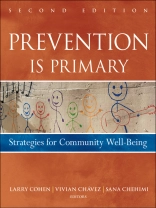The new edition of Prevention Is Primary provides models,
methods, and approaches for building health and equity in
communities. This comprehensive book includes the theory, concepts,
and models needed to harness social justice and practice primary
prevention of unnecessary illness and injury. Ideal for students as
well as practitioners, this thoroughly revised and updated second
edition combines an overview of advances in the field with
effective approaches in the current economic and health care
climate.
With contributions from noted experts, Prevention Is Primary
shows practical applications of intervention science to social and
health problems and issues facing at-risk and vulnerable groups.
The book describes the overarching framework and principles guiding
prevention efforts, including a focus on social justice and health
equity, and community resilience. It explores the transition from
prevention theory to implementation and practice and from
interdisciplinary collaboration to evaluation. Highlighting the
book’s usefulness as a teaching and learning tool, Prevention Is
Primary has real world examples, learning objectives, and review
questions for each chapter.
Spis treści
Tables, Figures, and Exhibits.
Acknowledgments.
Foreword (Georges C. Benjamin).
The Contributors.
Introduction (Larry Cohen, Vivian Chávez and Sana
Chehimi).
Part One: Defining the Issues.
1 The Imperative for Primary Prevention (Larry Cohen and Sana
Chehimi).
2 Achieving Health Equity and Social Justice (Wayne H. Giles and
Leandris C. Liburd).
Sidebar: Dolores Acevedo-Garcia, Nancy Mc Ardle, Theresa L.
Osypuk, Bonnie Lefkowitz and Barbara Krimgold.
3 Individual, Family, and Community Resilience (Bonnie
Benard).
Part Two: Key Elements of Effective Prevention
Efforts.
4 Community Organizing for Health and Social Justice (Vivian
Chávez, Meredith Minkler, Nina Wallerstein and Michael S.
Spencer).
5 Working Collaboratively to Advance Prevention (Larry Cohen and
Ashby Wolfe).
Sidebars: Deborah Balfanz, Soowon Kim and Ellen Wu.
6 The Power of Local Communities to Foster Policy (Makani
Themba-Nixon).
7 Using Media Advocacy to Influence Policy (Lori Dorfman).
8 The Impact of Corporate Practices on Health and Health Policy
(Nicholas Freudenberg and Sandro Galea).
9 Primary Prevention and Program Evaluation (Daniel
Perales).
Part Three: Prevention in Context.
10 Preventing Injustices in Environmental Health and Exposures
(Stephanie Ann Farquhar, Neha Patel and Molly Chidsey).
Sidebars: Nancy M. Goff and Peter Murchie.
11 Health and the Built Environment (Howard Frumkin and Andrew
L. Dannenberg).
12 Creating Healthy Food Environments to Prevent Chronic
Disease
(Leslie Mikkelsen, Catherine S. Erickson, Juliet Sims and Marion
Nestle).
13 A Public Health Approach to Preventing Violence (Deborah
Prothrow-Stith and Rachel A. Davis).
Sidebar: Dionne Smith Coker-Appiah, Mysha R. Wynn and Donald
Parker.
14 The Limits of Behavioral Interventions for HIV Prevention
(Dan Wohlfeiler and Jonathan M. Ellen).
15 Mental Health in the Realm of Primary Prevention (Anita M.
Wells, Gi Shawn A. Mance and M. Taqi Tirmazi).
Sidebar: Joseph P. Gone.
Name Index.
Subject Index.
O autorze
Larry Cohen, MSW, is the founder and executive director of the
Prevention Institute, Oakland, California.
Vivian Chavez, Dr PH, MSW, is an associate professor in the
department of health education at San Francisco State
University.
Sana Chehimi, MPH, is program manager at the Prevention
Institute.












